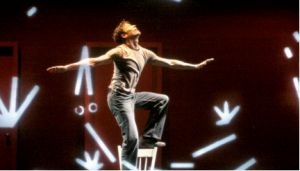Norman McLaren said “every film is a kind of dance”[1] and that “an abstract film has much greater affinity to music, ballet and dance than it has to any kind of abstract painting.”[2] He said he might have wanted to be a dancer if he had grown up in London.
Karen Beckman, in the introduction to Animating Film Theory, recently raised the intriguing question of what to think when McLaren himself “makes clear that motion is not a given in animation.” McLaren himself differentiated between his “abstract film… interested in motion for motion’s sake” and his “work with live people, dancers in particular.” However, there are unifying forces between two seemingly polarized categories of McLaren’s filmography: films, which incorporate live action and films that do not. One is dance; broadly speaking, it is movement.
In McLaren’s films, human dancers can become abstractions. He began experimenting with this early on in student films from the 1930s such as Camera Makes Whoopee and Polychrome Fantasy; he created a masterpiece with this transformation, Pas de Deux (1968). Inversely, in McLaren’s films abstractions can be embodied as dancing beings, such as in Spheres (1969), a version of which McLaren first worked on under the working title Chalk River Ballet.
Pas de deuxbyNorman McLaren, National Film Board of Canada
Spheres byRené Jodoin&byNorman McLaren, National Film Board of Canada
McLaren did eventually live in London for a period during his early twenties. At the time, he loved to attend the ballet but the seats he could afford were so far up on the balcony that what he was often watching was the movements of the dancer’s heads. Seeing human dancers, live, became an abstract artistic experience for the young McLaren. In a feedback cycle that runs throughout his career, dancers transform into abstractions and abstractions transform into dancers.
This cycle of abstraction and embodiment informs contemporary works which explore McLaren, especially dance works such as 4D Art’s NORMAN or studies by Tricia Anderson.
4DArt founder Michel Lemieux told me he was particularly inspired by the London ballet anecdote. He learned it while researching NORMAN, where a performer uses only their muscle memory to dance with 3D projections—which he cannot see—of McLaren films and interviews about McLaren. In other words, 4DArt choreographed a dance between a human and the embodiment of “animation.” This is a truly fitting tribute to McLaren as it “animates” “animation”; it brings the medium to life and into our three-dimensional world.
Our minds are quick to endow moving objects with a living quality. McLaren, like every animator, posseses the talents of Dr. Frankenstein. In NORMAN, 4D Art is Frankenstein, introducing footage of McLaren as a holograph who dances on the walls à la Fred Astaire. They have staged an eerie and beautiful resurrection.
[ylwm_vimeo width=”600″ height=”336″]69982681[/ylwm_vimeo]
The dichotomies implied in questions such as ‘In what way was McLaren a choreographer as well as an animator?’ or ‘Is Pas de Deux an abstract film although it incorporates live shots of dancers?’ are eroding. When Pas de Deux dancer Vincent Warren told me he believed that McLaren made some of the “greatest dance films in the 20th century,” he did not only mean the films featuring human dancers. The life and movement I sense in nearly all of McLaren’s films collapses them together into one category, regardless of whether they incorporate footage of human dancers. It could be fruitful to approach McLaren as above all a life-creator, a shaper of the metaphorical clay, and to analyze and theorize how abstraction and embodiment were not opposite but rather identical processes for McLaren.
McLaren wrote: “A basic quality of us human beings, and in fact all living creatures, is that we are always moving… It is this motion that is the heart of cinema.” And it’s this motion that is at the heart of life.
References
Many Norman McLaren films are available at: www.nfb.ca/explore-all-directors/Norman-McLaren
Beckman, Karen, ed. Animating Film Theory. Durham, USA: Duke University Press, 2014, p. 3.
Dobson, Terence. The Film-Work of Norman McLaren. Christchurch, N.Z.:, 1994.
Magisos, Melanie, “A Dictionary of Movement: An Interview with Norman McLaren With Grant Munro,” Wide Angle, Vol. 3, No. 4, 1980, p. 67.
McLaren, Norman, letter to Lorettan Devlin Gascard. 15 April 1981, p. 1. NFB Archives.
McLaren, Norman, interview by Donald McWilliams. June 1986, p. 13. Cinémathèque québécoise Archives.
McLaren, Norman, notes for a speech for a music festival at Aspen, Colorado, 1956. Reprinted in ASIFA, Vol. 15, No. 1, 1987, p. 1.
Crystal Chan will present a co-authored paper with Terence Dobson at the 2014 SAS Conference on Norman McLaren, which also identifies “movement” as a unifying factor in his filmography. However, they will analyze “movements” of another kind: the movement of McLaren across the globe during his travels and the relationships between McLaren’s films and sociopolitical mobilization. She is a journalist, researcher and author and the recipient of Canada Council for the Arts and Conseil des arts et des lettres du Québec grants to study McLaren. You can read her article on McLaren’s music in the April 2014 edition of Sight & Sound.


Reminds me of this quirky little student film from 1976:
https://vimeo.com/22219297